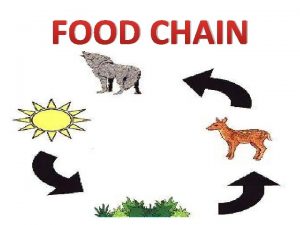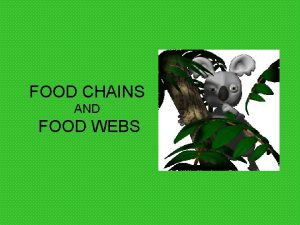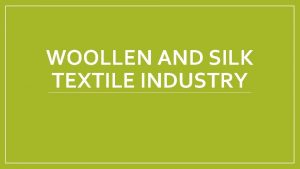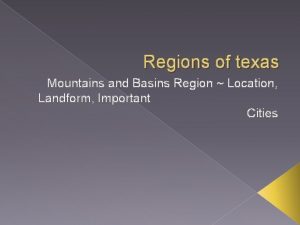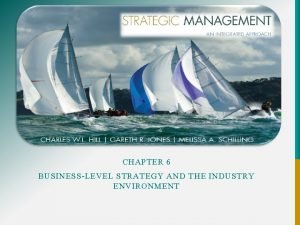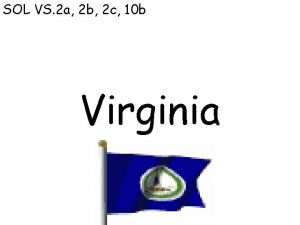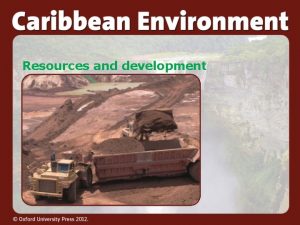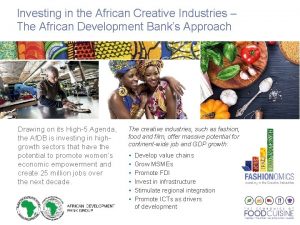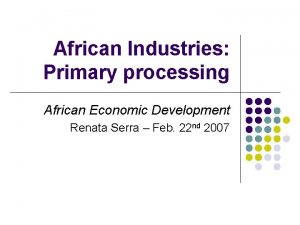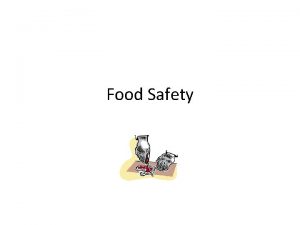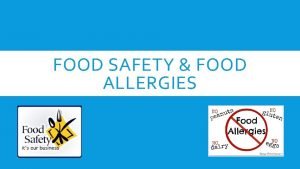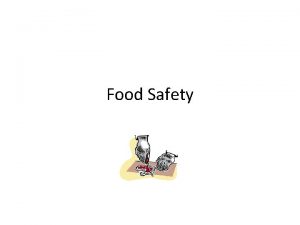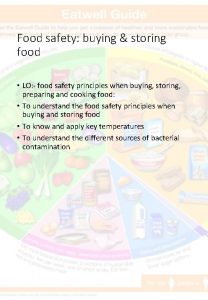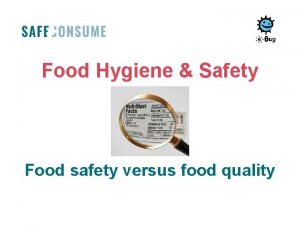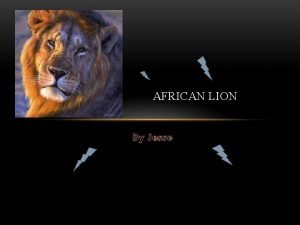Food Safety in African Food Industries and its























- Slides: 23

Food Safety in African Food Industries and its Management to meet EU’s Safety Standards – Case for Fish Industry in Kenya Prof Samuel K Mbugua Ph. D Department of Food Science Nutrition & Technology, College of Agriculture & Veterinary Science. University of Nairobi ICFMH - African Workshop on Improving the Microbiological Safety of African Food Products Towards Local and Global Markets Accra, Ghana 16 - 20 June, 2014

Presentation Outline (1) Value Chains and Supply chains definition (2) Value Chains and Supply chains distinction on their operations and responsibilities in QMS (3) Contexturizing business operation of African food enterprises with food value chain (4) Barriers/challenges faced in adopting QMS. (5) Case for Fish Value Chains in Kenya (6) Status of Fish processing in Kenya (7) Fish products exported from Kenya. (8) Challenges for fish sourced from Lake Victoria (9) Potential hazards (10) Food safety standards and adopted QMS (11) Case for Victorian Foods, an SME in fish business (12) Conclusion (13) References

Definition and distinction for Value and Supply Chains (1) • Both carry elements of value addition through incremental value in price or expanded market • Under Value Chain, value addition attributable to incremental value through products differentiation based on products’ attributes eg: Functionality, Safety, Geographical location and Environmental stewardship. • Under supply chain, value addition attributable to incremental value due to sets of values articulated by interacting food business enterprises (supply chain), with common business objective • Majority of food value chains (constituting food industry) embrace both characteristics of food supply network and product differentiation. • Typical food supply chain is depicted as: Inputs Producer Processor Distributor Wholesaler Retailer Consumer • Both aspects of value addition carry an equally critical role and responsibility of incremental value attributable to food safety.

Definition and Distinction of Value and Supply Chains (2) (A) As Traditional food supply chains with the following characteristics: Ø Business within food supply chain framed on win-lose terms – based on competition/adversarial relationship (ie buy as cheaply and sell as expensively possible) Ø Producers eg farmers/fishers exploited and not as strategic partners, and bear any arising risk. Ø Benefits/profits accruing to value addition in the chain unevenly distributed across supply chain, with processors and marketers receiving the highest share. Ø Control and coordination of supply chain operations is top -bottom ( ie Nationally or Internationally)

Definition and Distinction of Value and Supply Chains (2) (B) As Food Value Chain with following characteristics: Ø Business within food supply chain framed in win-win terms and on collaborative principles, implying high level of trust. Ø Business relationships take the form of strategic partnerships with responsibilities related to value chain information, risk taking, governance and decision making. Ø Commitments made for the welfare of all in a value chain, including adherence to rules, regulations and set standards. Ø Control and coordination can be managed from local, regional, national and international levels. Ø Main difference between traditional supply and food value chains is operation on strategic partnership basis and differentiation of their products focusing on quality, functionality, environmental and social attributes, which have defined the unraveling changes and requirements at the global market

External (to business)Barriers/Challenges to meeting safety standards • Majority African Food enterprises conceptually operated more as food supply chains • As such unable to influence other actors in the chain on issues of value addition including quality of raw materials etc because of nature of the chain. • Unable sustain basic hygiene due to poor facilities and lack of financial support. • Lack access to quality technical training.

Internal(to business) Barriers/Challenges by African Food Enterprises to meeting safety standards • • Some very simple: Producer Consumer; and easier adoption of QMS due to Flexibility and potential Innovativeness. However, Simplicity advantage overtaken by other barriers such as: Inadequate knowledge, Unstable economic status and lack of need appreciation for QMS. CEO’s perception s and attitudes (cultural ? ) by CEO not conducive to sensitivity to GHP Complacency and inertia by CEO to change with new developments and requirements (need appreciation) in businesses. Inability to understand appreciate the benefits derived from investing in food safety quality. Lack of technical competency and business skills to operate effective pre-requisite programs, and setting up QMS Lack of enforcement of quality standards and effective penalties for violation often attributed to corruption (Case of deaths in Kenya on selling illicit drinks) Ignorance by Consumers and customers for safety requirements, and willing risk in poor quality products at the expense of perceived “low cost”

Case for Fish Value Chains in Kenya (CF & AF= Commercial & Artisanal Fishing respectively) CF AF Iced Transport Filleting plant Local & Export market Indian Ocean Lake Turkana Lake Victoria Kisumu Market Fish traders Restaurants & Women Street Fryers Fish Farms CF/AF Beach Drying Fish traders CF AF Fish Traders Iced Transport Fish Trader Public transport Filleting Plant Human & Chicken Feed Local & Export Market Home Consu mption Iced Transport Hotels & Urban Markets

Industrial Fish Processors, Capacities and level of utilization Category Establishments Capacity (MT/day) Capacity in use % Usage (MT/day) Land-based (fresh water) 8 275 90 (2 are closed) 33 Land-based (Marine) 5 144. 5 71. 2 50 Water-based Freezer vessels 4 8 0. 8 10 Total 17 427. 5 162 38 Source: Manyala 2011.

Fish export products from Kenya in 2012

Challenges for fish sourcing from Lake Victoria • Poor fishing practices (destroying breeding grounds and over fishing) • Pollution of the lake with human waste sewage, industrial and agricultural chemicals. • Water hyacinth that hampers fishing activities and whose growth is encouraged by pollution • Lack of correct fishing gear for SMEs • Lack of adequate facilities for storage and transportation of fish. • Poor enforcement of policy on fishing unlike in Ugandan and Tanzanian side • Socio economic factors such as poor education and high HIV prevalence among fishing folks and lack of good health care centers.

Potential Hazards • Pollution of lake and fishing grounds (no comprehensive data on quantification along the chain) • Bacteria of human waste origin for fish from ponds, lakes and ocean (1997 and 1998 outbreaks for Salmonella and Cholera among Lake Victoria fishing communities – Abila, 2003) • Poor hygienic handling and use of non-potable water exposing fish to hazards such as Salmonella, S. aureus and Listeria monocytogenes • Industrial effluent leading to chemical hazards namely heavy metals; cadmium, mercury, lead etc. • Pesticides in lake from agricultural activities and accumulation in fish. • Use of Non-foodgrade materials for fish transportation by artisinal fish sector (Small businesses)

Food safety standards, and adopted QMS • Standards adhered to for fishing, transportation and delivery to processing plant are EC No. 852/2000 and EC No 853, 854/2004. • No available protocol for fishing to preserve quality and safety is followed. • Most processing plants follow a not well structured and tailor-designed HACCP system • Fisher men and transporters use experience gathered over years to deliver fish to processing plants and market, but have been forced to use ice by market forces. • However industrial fish processors operate within set minimum time for fishing and landing, own modern fishing gear and refrigerated trucks, and use ice

Case for Victorian Foods at Kitale – Fish processing flow chart (Fish sourced from Lake. Turkana) Nile Perch reception Cleaning Filleting Skinning Distribution Trimming Blast Freezing Packaging Sizing





Challenges at Victorian Foods • No electricity at lake Turkana, fish has to be trucked 300 km to Kitale plant using refrigerated truck. • Turbulence at the lake cause delaid fish landing and effective chilling using ice • Unstable local market and low pricing • Long credit period by supermarkets (90 days) and lack of access to financial credit. • High costs of fish supply due to distance and low market prices controlled by large firms. • Low fish supply due to low capacity fishing vessels in the turbulent lake. • Main market in Nairobi about 500 km away.

Potential for Fish sourcing from Lake Turkana • Lake Turkana said to be the largest permanent desert lake with vast unexploited fish. • Good fishing practices regulated by Ministry of wild life • No pollution for lack of industrial and agricultural activities on its shores • Abundance of good quality fish in clean water.

Challenges for fish sourcing from Lake Turkana • Region inhabited by pastoralists and insecure due to livestock rustling • Fisher men not motivated and dependent livestock and relief food • No electricity (recently center for oil fields discovery) or piped water for ice production and has to be brought in over many kms • Weather very harsh with winds creating turbulent and dangerous lake • Lack of powerful fishing gears and boats.

Conclusions on Capacity and Challenges for Fish businesses on Fish safety quality management • There is need to find way of removing the presumption of prohibitive cost in putting up QMS by the SMEs by making it easily adoptable and affordable • There is need for government intervention in forging operational structures for food enterprises along value chain approach with win – win frame in order to embrace QMS as a critical element in products differentiation and value addition. • The need for government as strategic partner in food value chains to accelerate provision of enabling environment in credit, infrastructure (electricity, potable water, communications etc), regulatory and enforcement services and motivation, for compliancy to food safety quality management protocols. • The need to educate CEOs for the SMEs and train staff on setting up, operation and management of holistic QMS • The need to sensitize consumers on importance of food safety and the cost likely to be incurred on addressing health problems, compared to saving on purchasing food not certified for quality.

References (1) Amban Andrew; CEO, Victorian Foods ltd, Kitale, Kenya. (2) Dordevic et al 2010; Development of Integrated Managing System (IMS) for SMEs in Serbia. International Working Conference. Total Quality Management, Belgrade. (3) Manyala J O, 2011: Fishery value chain analysis, Background report – Kenya NORAD, FAO Rome. (4) Onyango Stanley, Fishery Officer, Kenya Marine and Fishery products. Mombasa, Coast County, Kenya. (5) Value – Based Food Supply Chains: - Strategies for Agri – Food Enterprises. gwsteven@wisc. edu, rspirog@iastate. edu
 Examples of bulk reducing industry
Examples of bulk reducing industry What is a lion in the food chain
What is a lion in the food chain What is food safety
What is food safety The emigree and london comparison
The emigree and london comparison Its halloween its halloween the moon is full and bright
Its halloween its halloween the moon is full and bright When a train increases its velocity its momentum
When a train increases its velocity its momentum Cloudy sunny rainy windy
Cloudy sunny rainy windy If its square its a sonnet summary
If its square its a sonnet summary Its not easy but its worth it
Its not easy but its worth it Unit 2 food food food
Unit 2 food food food Eltonian pyramid
Eltonian pyramid Catzoc ecdis definition
Catzoc ecdis definition Safety care behavioral safety training
Safety care behavioral safety training Process safety vs personal safety
Process safety vs personal safety Safety assessment for ind safety reporting
Safety assessment for ind safety reporting Basic safety orientation
Basic safety orientation Basic safety orientation
Basic safety orientation Food web words
Food web words Distribution of cotton woollen and silk industries map
Distribution of cotton woollen and silk industries map Mountains and basins region of texas landforms
Mountains and basins region of texas landforms Fragmented industry
Fragmented industry State tree
State tree Aerospace and defence industries association of europe
Aerospace and defence industries association of europe Is fishing primary secondary or tertiary
Is fishing primary secondary or tertiary

